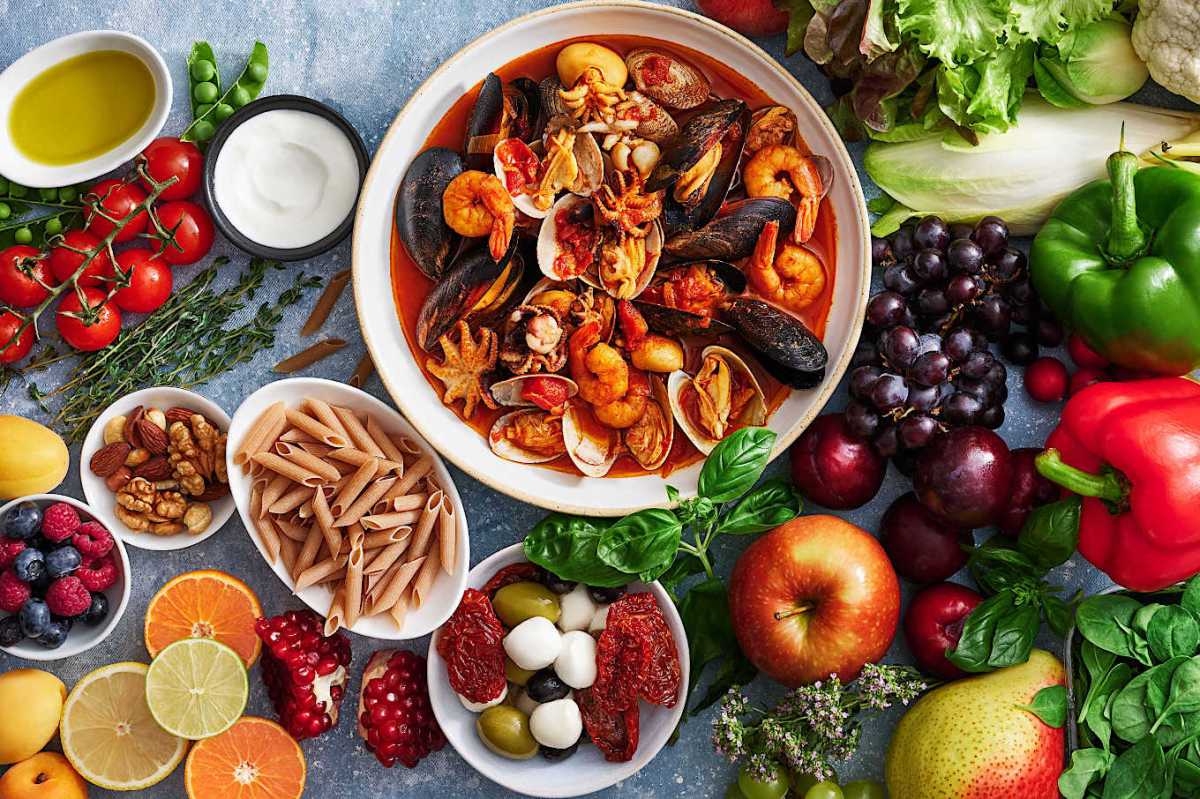Embark on a culinary journey through the sun-drenched landscapes of the Mediterranean, where vibrant flavors and wholesome ingredients dance on your palate. This collection of soy-free recipes celebrates the heart of the Mediterranean diet, adapting its renowned health benefits to suit those seeking a soy-free lifestyle. Imagine plates bursting with the rich colors of ripe tomatoes, the earthy aroma of olives, and the satisfying crunch of fresh vegetables – all prepared with simple, accessible ingredients and presented in a way that is both visually stunning and incredibly delicious. Prepare to rediscover the joy of healthy eating with each bite.
We’ll explore the fundamental principles of the Mediterranean diet, highlighting its inherent soy-free compatibility, and providing a comprehensive list of key ingredients. From light and refreshing breakfasts to hearty and flavorful dinners, we’ll guide you through a variety of recipes, each meticulously crafted with step-by-step instructions, nutritional information, and captivating visual descriptions. We’ll even delve into creating a balanced weekly meal plan, incorporating meal-prepping strategies and addressing potential challenges to help you seamlessly integrate this vibrant, healthy, and soy-free way of eating into your daily life.
Mediterranean Diet Basics (Soy-Free)
The Mediterranean diet, renowned for its health benefits, emphasizes whole, unprocessed foods. A soy-free adaptation maintains the core principles while excluding soy products, ensuring a diverse and nutritious eating plan. This approach focuses on the abundance of fresh produce, healthy fats, and lean protein sources characteristic of the traditional Mediterranean diet, but without the inclusion of soy.
Core Principles of the Soy-Free Mediterranean Diet
The foundation of a soy-free Mediterranean diet rests on consuming generous portions of fruits and vegetables bursting with vibrant colors, a rainbow reflecting the diverse phytonutrients they offer. Olive oil, a cornerstone of the diet, provides healthy monounsaturated fats, adding richness and flavor to dishes while contributing to cardiovascular health. Lean protein sources like fish, poultry, and legumes (excluding soy-based ones) are integral, offering essential amino acids. Whole grains, such as barley, quinoa, and brown rice, provide sustained energy and fiber, supporting digestive health. Finally, nuts and seeds (excluding soy nuts), rich in healthy fats and antioxidants, add satisfying crunch and nutritional depth to meals. Moderation is key; red meat and processed foods are consumed sparingly.
Common Mediterranean Ingredients (Soy-Free)
The following table details common Mediterranean ingredients suitable for a soy-free diet, highlighting their nutritional benefits and typical culinary applications.
| Name | Nutritional Benefits | Common Uses | Soy-Free Alternatives (if applicable) |
|---|---|---|---|
| Olive Oil | Rich in monounsaturated fats, antioxidants; supports heart health. | Salad dressings, cooking, dipping bread. | N/A |
| Fruits (e.g., oranges, grapes, figs) | Vitamins, minerals, fiber; supports immune function, digestive health. | Snacks, desserts, salads, main courses. | N/A |
| Vegetables (e.g., tomatoes, cucumbers, zucchini) | Vitamins, minerals, fiber; supports immune function, digestive health. | Salads, stews, side dishes. | N/A |
| Whole Grains (e.g., barley, quinoa, brown rice) | Fiber, complex carbohydrates; sustained energy, digestive health. | Side dishes, salads, main courses. | N/A |
| Legumes (e.g., lentils, chickpeas, beans – excluding soy) | Protein, fiber, iron; supports satiety, digestive health. | Soups, stews, salads, dips. | N/A |
| Fish (e.g., salmon, tuna, sardines) | Omega-3 fatty acids, protein; supports heart health, brain function. | Grilled, baked, in salads. | N/A |
| Poultry (e.g., chicken, turkey) | Lean protein; supports muscle growth and repair. | Grilled, roasted, in stews. | N/A |
| Nuts & Seeds (e.g., almonds, walnuts, sunflower seeds) | Healthy fats, protein, fiber; supports heart health, satiety. | Snacks, salads, added to dishes. | N/A |
| Herbs & Spices (e.g., oregano, basil, rosemary) | Antioxidants, flavor enhancers; supports overall health. | Added to dishes for flavor. | N/A |
Health Benefits of a Soy-Free Mediterranean Diet
Following a soy-free Mediterranean diet offers numerous health advantages. The abundance of fruits and vegetables provides a wealth of vitamins, minerals, and antioxidants, bolstering the immune system and reducing the risk of chronic diseases. The emphasis on healthy fats from olive oil contributes to cardiovascular health by lowering LDL cholesterol and improving blood pressure. Lean protein sources support muscle mass and satiety, aiding in weight management. The high fiber content promotes healthy digestion and helps regulate blood sugar levels. Furthermore, the reduced consumption of processed foods and red meat minimizes exposure to harmful chemicals and saturated fats, reducing the risk of heart disease and certain cancers. A well-planned soy-free Mediterranean diet provides a holistic approach to health and well-being, promoting longevity and vitality.
Soy-Free Mediterranean Breakfast Recipes

Embark on a flavorful and healthy journey with these three unique soy-free Mediterranean breakfast recipes, designed to nourish your body and delight your senses. Each recipe is crafted with fresh, vibrant ingredients, reflecting the essence of the Mediterranean diet while adhering to soy-free principles. These options provide a balanced start to your day, packed with essential nutrients and bursting with Mediterranean flavors.
Mediterranean Avocado Toast with Egg
This recipe offers a creamy, savory breakfast that’s both quick and satisfying. The vibrant green avocado contrasts beautifully with the golden-yellow egg yolk, creating a visually appealing and nutritionally rich meal.
- Toast a slice of whole-wheat bread until golden brown.
- Mash half an avocado with a fork and spread it evenly over the toast.
- Fry or poach an egg to your liking and place it gently on top of the avocado.
- Season with salt, pepper, and a sprinkle of red pepper flakes for a touch of heat (optional).
- Garnish with a drizzle of olive oil and a few fresh herbs, such as dill or parsley.
Nutritional Information (per serving): Calories: Approximately 350; Protein: 10g; Fat: 25g; Carbohydrates: 25g.
Visual Representation: Imagine a rustic wooden board holding a single slice of whole-wheat toast, its surface generously coated with a vibrant, creamy green avocado mash. A perfectly cooked egg, its yolk a rich golden yellow, sits proudly atop the avocado. Tiny flecks of red pepper flakes add a subtle pop of color, while a delicate drizzle of olive oil creates glistening highlights. Fresh, bright green herbs add a final touch of freshness. The overall effect is one of rustic elegance and wholesome goodness.
Greek Yogurt with Berries and Honey
This recipe is a refreshing and light breakfast option, perfect for warmer mornings. The creamy texture of the yogurt complements the juicy sweetness of the berries, creating a harmonious blend of flavors and textures.
- Place a generous dollop of plain, full-fat Greek yogurt (ensure it’s soy-free) in a bowl.
- Top with a mix of fresh berries such as raspberries, blueberries, and strawberries. The vibrant reds, deep blues, and bright pinks create a stunning visual contrast against the creamy white yogurt.
- Drizzle with a small amount of local honey for sweetness and a touch of golden amber color.
- Optional: Sprinkle with a handful of chopped walnuts or almonds for added crunch and healthy fats.
Nutritional Information (per serving): Calories: Approximately 200; Protein: 15g; Fat: 8g; Carbohydrates: 20g.
Visual Representation: A simple yet elegant presentation features a pristine white bowl filled with thick, creamy Greek yogurt. A vibrant medley of fresh berries – deep red raspberries, plump blueberries, and juicy strawberries – is artfully scattered across the yogurt’s surface. A delicate drizzle of golden honey forms thin, glistening threads, adding both sweetness and visual interest. The overall color palette is bright and cheerful, suggesting freshness and health.
Mediterranean Quinoa Breakfast Bowl
This hearty and nutritious bowl is packed with protein and fiber, providing sustained energy throughout the morning. The combination of textures and flavors creates a complex and satisfying breakfast experience.
- Cook 1/2 cup of quinoa according to package directions.
- Chop 1/2 cup of cucumber into small cubes and 1/4 cup of red onion into thin slices. The contrasting colors and textures add visual appeal.
- Combine the cooked quinoa, cucumber, and red onion in a bowl.
- Add 1/4 cup of crumbled feta cheese (a key element of the Mediterranean diet) and a handful of Kalamata olives. The salty feta and briny olives add a savory counterpoint to the fresh vegetables.
- Drizzle with olive oil and lemon juice, and season with salt and pepper to taste.
Nutritional Information (per serving): Calories: Approximately 300; Protein: 12g; Fat: 10g; Carbohydrates: 45g.
Visual Representation: A rustic bowl is filled with fluffy, light-colored quinoa, forming a base for the other ingredients. Bright green cucumber cubes and thin, purplish-red onion slices are scattered throughout, providing a visual contrast. Small, dark Kalamata olives add pops of intense color, while the creamy white feta cheese provides textural contrast. A light drizzle of olive oil creates a sheen, and the overall presentation is both simple and appealing, reflecting the natural beauty of the ingredients.
Creating a Weekly Soy-Free Mediterranean Meal Plan
Embarking on a soy-free Mediterranean diet can feel daunting, but with careful planning and preparation, it becomes a vibrant and delicious journey. This section provides a sample weekly meal plan, incorporating recipes previously discussed, along with practical strategies for efficient meal prepping and addressing potential challenges. The goal is to create a sustainable and enjoyable eating pattern that supports your health and well-being.
A well-structured weekly meal plan is crucial for successful adherence to any dietary regime. This plan incorporates a balance of flavors, textures, and nutrients, ensuring variety and minimizing the risk of dietary boredom. Meal prepping significantly reduces time spent cooking during the week, making the soy-free Mediterranean diet more manageable.
Sample Weekly Soy-Free Mediterranean Meal Plan
This sample plan assumes you have already prepared some key elements like roasted vegetables or cooked grains in advance. It showcases the versatility of Mediterranean cuisine without soy. Remember to adjust portion sizes to meet your individual caloric needs.
| Day | Breakfast | Lunch | Dinner |
|---|---|---|---|
| Monday | Greek Yogurt (soy-free) with berries and a sprinkle of almonds | Large salad with chickpeas, cucumber, tomatoes, olives, and a lemon-herb vinaigrette | Baked cod with roasted vegetables (zucchini, bell peppers, eggplant) and quinoa |
| Tuesday | Scrambled eggs with spinach and feta cheese | Leftover baked cod and roasted vegetables | Lentil soup with a side of whole-wheat pita bread |
| Wednesday | Oatmeal (soy-free) with fruit and a drizzle of honey | Tuna salad (made with mayonnaise without soy lecithin) on whole-wheat crackers with a side of cherry tomatoes | Chicken skewers with a lemon-herb marinade, served with a side of brown rice and steamed green beans |
| Thursday | Smoothie made with soy-free milk (almond or coconut), spinach, banana, and berries | Leftover chicken skewers and brown rice | Falafel (ensure they are soy-free) in pita bread with hummus and a side salad |
| Friday | Greek Yogurt (soy-free) with chopped fruit and a sprinkle of walnuts | Large salad with grilled chicken or fish, mixed greens, and a balsamic vinaigrette | Lamb chops with roasted potatoes and asparagus |
| Saturday | Shakshuka (eggs poached in a tomato and pepper sauce) with whole-wheat toast | Leftover lamb chops and roasted potatoes | Homemade pizza with whole-wheat crust, tomato sauce, vegetables, and feta cheese |
| Sunday | Pancakes made with soy-free flour blend and topped with fresh fruit | Leftover pizza | Roasted chicken with roasted root vegetables (carrots, sweet potatoes, parsnips) |
Meal Prepping and Efficient Cooking Techniques
Effective meal prepping involves strategically preparing components of meals in advance. For instance, roasting a large batch of vegetables on Sunday can provide ingredients for several dinners throughout the week. Cooking grains like quinoa or brown rice in bulk also saves significant time. Utilizing slow cookers or Instant Pots allows for hands-off cooking, ideal for busy individuals. Pre-chopping vegetables and storing them in airtight containers further streamlines the weeknight cooking process. Visualize a brightly lit kitchen counter, organized with neatly labeled containers of prepped ingredients, ready for quick assembly into delicious meals.
Potential Challenges and Solutions
One potential challenge is the hidden presence of soy in processed foods. Many sauces, condiments, and baked goods contain soy lecithin or soy protein. Carefully reading food labels and opting for whole, unprocessed ingredients is crucial. Another challenge is finding soy-free alternatives to common soy-based products. Fortunately, many delicious alternatives exist, such as almond milk, coconut yogurt, and tofu substitutes made from chickpeas or other legumes. If eating out, communicating dietary needs clearly to restaurant staff is essential. A picture of a soy-free menu item on your phone can also help ensure accurate ordering. Imagine the satisfaction of successfully navigating a restaurant menu, confident in your ability to enjoy a delicious and healthy soy-free Mediterranean meal.
This culinary adventure through soy-free Mediterranean cuisine has unveiled a world of vibrant flavors and nourishing possibilities. From the simple elegance of a sun-kissed breakfast to the comforting warmth of a hearty dinner, each recipe showcases the beauty and versatility of this adaptable diet. By embracing the fresh ingredients, mindful preparation, and balanced approach of the Mediterranean lifestyle, you can create meals that are not only delicious and visually appealing but also contribute to a healthier, happier you. So, gather your ingredients, embrace the sunshine in your kitchen, and embark on this delicious journey towards a vibrant and healthy future.
FAQ Overview
What are the best substitutes for soy sauce in Mediterranean cooking?
Lemon juice, red wine vinegar, or a combination of herbs and spices can effectively replace soy sauce, offering similar umami notes.
Are all nuts and seeds suitable for a soy-free Mediterranean diet?
Most nuts and seeds are naturally soy-free, but always check labels to ensure they haven’t been processed in facilities that also handle soy.
Can I adapt existing Mediterranean recipes to be soy-free?
Absolutely! Many traditional Mediterranean recipes are naturally soy-free. Carefully review ingredients and substitute soy-containing products (like soy sauce or soy milk) with suitable alternatives.
How do I ensure my pantry is fully stocked for soy-free Mediterranean cooking?
Stock up on olive oil, herbs, spices, various vegetables, legumes (excluding soy-based ones), and a variety of fruits. Check labels carefully to avoid hidden soy ingredients.


